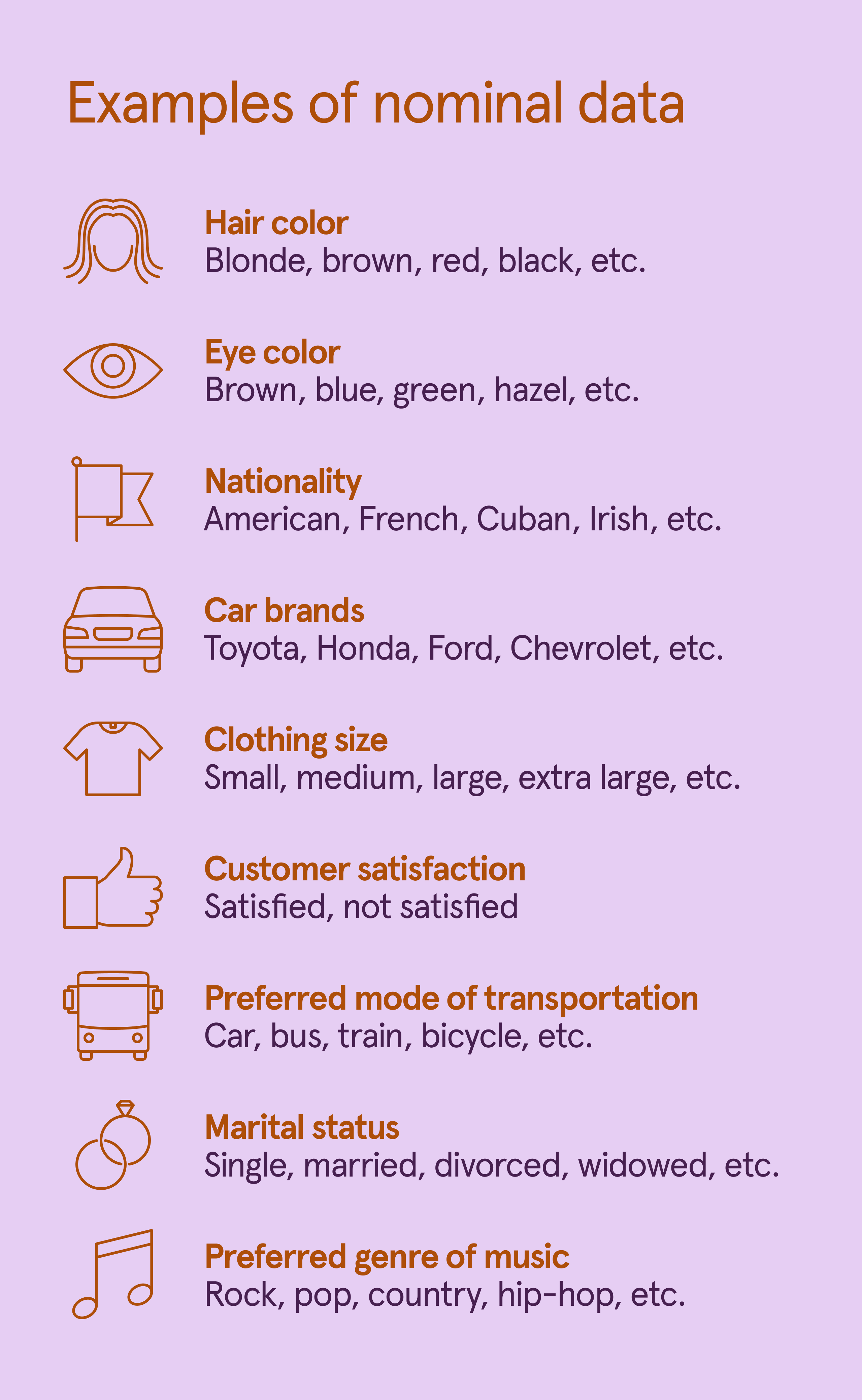Our view at Stack - Typeform is our go-to software if we need to ask a set of structured questions of a group of customers, prospects or leads. In summary, Typeform combines aesthetics, functionality, and flexibility. User-friendly form builder with interactive design, versatile question types, real-time data collection, 500+ integrations, and diverse templates. Ideal for engaging surveys and lead generation.
Ever wonder how data is categorized? How do people rank scores, draw conclusions about product reviews, or conduct simple yes/no survey questions? These are all types of measured data, but they’re measured differently.
Understanding data types is crucial for any analysis, as it determines the most appropriate statistical methods to use. In the world of data, two fundamental types you’ll encounter are nominal and ordinal data.
Nominal data refers to categories with no inherent order, while ordinal data involves categories with a ranking or sequence.
We’ll dive into the key differences between nominal vs. ordinal data, along with examples to illustrate their usage in various contexts. By understanding these distinctions, you’ll be well equipped to interpret data effectively and draw meaningful conclusions from your analyses.
Latest posts on Tips
What is nominal data?
Nominal data, also known as categorical data, is a type of qualitative data that represents categories or classifications. This type of data is also known for being sorted into groups. Nominal data doesn’t have a set order or hierarchy when sorted––these variables also don’t represent any kind of measurement.
You can use the nominal level of measurement by dividing variables with no mathematical value into categorized groups. Since variables are ranked by their names, there isn’t an order or hierarchy organically associated with them.
Nominal data examples
Nominal data examples include a person’s gender, eye color, or ethnicity. Since these nominal data categories aren’t associated with specific numbers, they are ranked by category instead. You can then give these arranged groups corresponding numbers to collect and analyze the data.
Here’s a closer look at nominal data examples:

Demographics:
-
Hair color: Blonde, brown, red, black, etc.
-
Eye color: Brown, blue, green, hazel, etc.
-
Nationality: American, French, Cuban, Canadian, Irish, etc.
Products and services:
-
Car brands: Toyota, Honda, Ford, Chevrolet, etc.
-
Clothing size: Small, medium, large, extra large, etc.
-
Customer satisfaction: Satisfied, not satisfied
Surveys and questionnaires:
-
Preferred genre of music: Rock, pop, country, hip-hop, etc.
-
Preferred mode of transportation: Car, bus, train, bicycle, etc.
-
Marital status: Single, married, divorced, widowed, etc.
What is ordinal data?
Ordinal data, also known as ranked data, is a step higher than nominal data––it involves categories that have natural order or ranking. The ordinal scale of ranking involves arranging data in a certain order in comparison with one another to rate different variables. The order of variables (like ascending or descending) is important here.
You can use ordinal data in market research, for example, to analyze feedback, perception, and even choices––then use this data to gauge customer satisfaction with the creation of surveys and forms.
Ordinal data examples
Ordinal data examples include rating your ordering experience or rating a product’s quality. The ordinal scale involves arranging data in a specific order to compare one another and essentially “rank” each variable.
Let’s take a look at some more ordinal data examples:

-
How satisfied are you with our product or service? (Very satisfied, Satisfied, Neutral, Dissatisfied, Very dissatisfied)
Movie ratings:
Social media sentiment analysis:
Education levels:
-
What is your highest level of education? (High school diploma, Associate degree, Bachelor’s degree, Master’s degree, Doctorate)
T-shirt sizes:
-
What size T-shirt do you wear? (Small, Medium, Large, Extra Large)
Restaurant experience:
-
Rate the food quality at this restaurant. (Excellent, Very good, Good, Average, Below average)
Key difference between nominal vs. ordinal
How the variables are measured is a key difference between nominal vs. ordinal data. Since each variable has a scale of degree (mathematical or categorical), you’ll be able to make informed decisions about your data. Let’s break down nominal and ordinal scales and data.
| Nominal data | Ordinal data | |
| Feature | Categorical | Ranked |
| Focus | Classification | Ranking |
| Order | No inherent order | Specific order |
| Mathematical operations | No | Limited |
| Main differences |
|
|
| Examples | Hair color (blonde, brunette, black, etc.), eye color (brown, blue, green, etc.), and blood type (O positive, O negative, A positive, etc.) | Customer satisfaction (very satisfied, not satisfied, neutral, etc.), movie rating (1-5 stars) and education levels (Bachelor’s, Master’s, Ph.D., etc.) |
Nominal data (categorical data):
-
Focuses on classification: Nominal data groups items into distinct categories that have no inherent order or ranking.
-
Related to labels: Imagine labels on boxes. Each box represents a category (e.g., shirt color) and the items inside (e.g., red shirts) belong to that specific group.
-
Limited math: You can’t perform mathematical operations like addition or subtraction on nominal data because the categories themselves don’t have a numerical value.
Ordinal data (ranked data):
-
Focuses on ranking: Ordinal data arranges items into categories with a specific order. There’s a clear hierarchy, but the intervals between categories aren’t necessarily equal.
-
Similar to levels: Imagine steps on a staircase. Each step represents a category (e.g., customer satisfaction), but the exact distance between steps (difference in satisfaction) might be subjective.
-
Order matters, measurement doesn’t: While you know “very satisfied” is better than “satisfied,” you can’t say someone who is “very satisfied” is twice as happy.
When to use nominal vs. ordinal data
Choosing between nominal vs. ordinal data depends on the kind of information you’re trying to capture. Here’s a breakdown of when to use each:
Use nominal data when:
-
You’re simply classifying items into distinct categories with no inherent order.
-
The categories themselves don’t have any numerical value.
-
You only care about identifying groups and not ranking them.
Use ordinal data when:
-
You want to rank items in a specific order, but the exact difference between those rankings isn’t important.
-
The categories have a clear hierarchy, but the intervals between them are subjective or not precisely measurable.
Scale your data with Typeform
Understanding the distinction between nominal vs. ordinal data is a fundamental step in data analysis. The ability to classify your data correctly will ensure you get the most out of your analysis and avoid misinterpretations.
Remember, nominal data helps categorize information, while ordinal data allows ranking within those categories.
So, next time you encounter data, ask yourself: Is it simply classified, or is there a ranking or order involved? The answer will guide you toward the most appropriate statistical analysis and clear, insightful results.
Whether you’re conducting surveys, analyzing marketing campaigns, or interpreting research findings, recognizing nominal and ordinal data will empower you to make more informed decisions.
Scale up your research with Typeform––create visually appealing forms and surveys designed to obtain maximum response. Choose from one of our customizable templates to take your branded forms to the next level.
If Typeform is of interest and you'd like more information, please do make contact or take a look in more detail here.
Credit: Original article published here.
